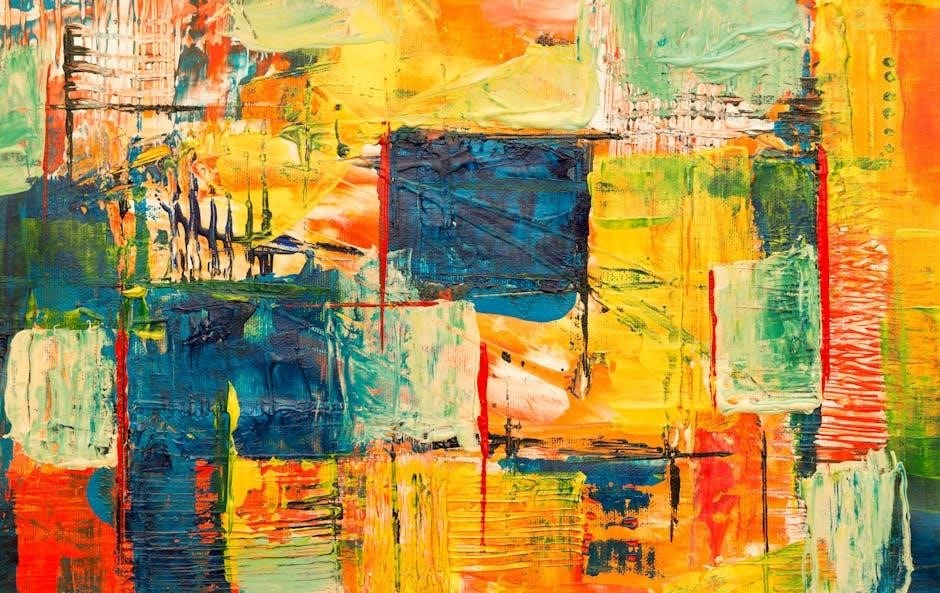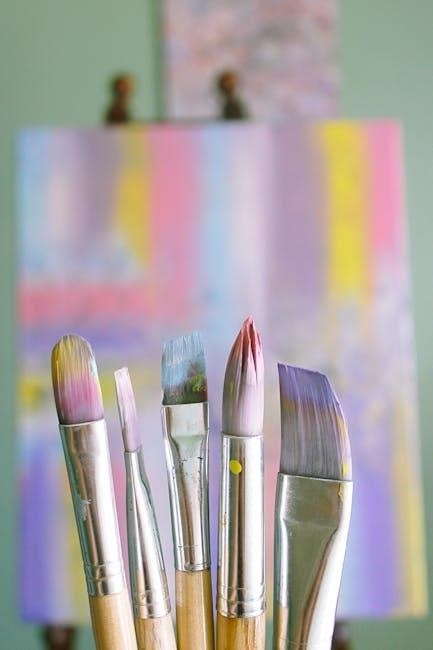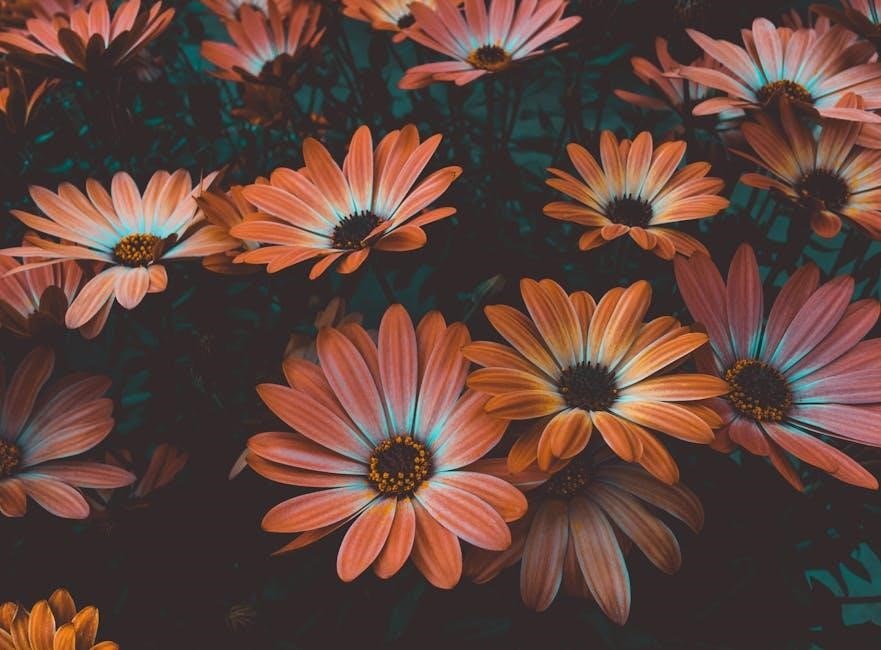Art & Fear by David Bayles and Ted Orland is a guide for artists exploring the challenges of creativity‚ offering insights into overcoming fears and fostering growth.
Overview of the Book and Its Relevance to Artists
Art & Fear by David Bayles and Ted Orland is a concise yet profound exploration of the challenges artists face in their creative journeys. Written by artists for artists‚ the book delves into the emotional and psychological barriers that often hinder artistic expression. It addresses fears such as failure‚ success‚ and self-doubt‚ offering practical advice to help artists overcome these obstacles. Bayles and Orland emphasize the importance of discipline‚ vulnerability‚ and persistence‚ encouraging artists to focus on the process rather than the outcome. The book’s relatable anecdotes and insightful observations make it a seminal text for creatives of all levels. Its relevance lies in its ability to resonate with artists’ universal struggles‚ providing reassurance and motivation to continue their craft despite the challenges they may face.

The Main Challenges Artists Face
Artists often grapple with fear‚ self-doubt‚ and the paralyzing effects of perfectionism‚ which can hinder their creative process and prevent them from fully expressing their artistic potential.
The Fear of Failure and Its Impact on Creativity
The fear of failure is a pervasive obstacle for many artists‚ often stifling creativity before it even begins. This fear manifests as a crippling anxiety about producing work that may not meet expectations or face rejection. Artists may hesitate to start projects‚ fearing judgment or disappointment‚ which can lead to creative paralysis. The authors emphasize that this fear is not only natural but also a recurring part of the artistic process. They suggest that anticipating failure can be more debilitating than the act of creating itself. By focusing on the fear of failure‚ artists often lose sight of the intrinsic value of the creative journey. The book encourages artists to acknowledge this fear but not let it dictate their actions‚ instead embracing the process and understanding that growth often emerges from perceived failures. This mindset helps build resilience and fosters a more liberated approach to artmaking. Overcoming the fear of failure requires perseverance and a willingness to take risks‚ ultimately leading to artistic growth and fulfillment.
Self-Doubt and the Psychological Barriers to Artmaking
Self-doubt is one of the most insidious psychological barriers to artmaking‚ often manifesting as a crippling uncertainty about one’s abilities or the value of their work. Artists frequently grapple with feelings of inadequacy‚ questioning whether their creations are meaningful or worthy of recognition. This internalized criticism can paralyze the creative process‚ causing artists to hesitate or even abandon their work altogether. The authors of Art & Fear highlight how self-doubt stems from the fear of not meeting expectations‚ whether self-imposed or external. They emphasize that this doubt is not a reflection of talent but rather a common experience shared by artists at all levels. To overcome this barrier‚ the book encourages artists to focus on the process of creating rather than the outcome‚ fostering resilience and a growth mindset. By acknowledging and accepting self-doubt as a natural part of the journey‚ artists can learn to move forward despite their fears‚ ultimately unlocking their creative potential. This shift in perspective allows for a more authentic and fulfilling engagement with artmaking.
The Fear of Success and Its Paralyzing Effects
The fear of success‚ though less commonly discussed‚ is a potent barrier for many artists. It manifests as anxiety about the implications of achieving recognition‚ such as heightened expectations‚ loss of creative freedom‚ or the pressure to consistently produce high-quality work. Artists may sabotage their efforts to avoid these perceived burdens‚ fearing that success will lead to criticism or demands they cannot meet. Art & Fear highlights how this fear can be as debilitating as the fear of failure‚ preventing artists from fully realizing their potential. The book encourages artists to reframe success as a natural outcome of their growth‚ rather than a source of dread. By embracing success as part of the artistic journey‚ creators can transcend this paralyzing fear and continue to evolve in their craft; This mindset shift allows artists to focus on the intrinsic rewards of artmaking rather than external pressures.

Practical Advice for Overcoming Creative Fears
Art & Fear suggests embracing regular practice‚ discipline‚ and vulnerability to overcome creative fears‚ fostering growth and resilience in the artistic journey.

The Importance of Regular Practice and Discipline
Art & Fear emphasizes that regular practice is essential for overcoming creative fears. By committing to a consistent routine‚ artists can transform creativity into a habit‚ reducing the grip of self-doubt and fear. The book suggests that even small‚ daily efforts can lead to significant progress over time. Discipline helps artists focus on the process rather than the outcome‚ fostering resilience and growth. Bayles and Orland encourage artists to show up regularly‚ even when inspiration is lacking‚ as this dedication builds momentum and confidence. Over time‚ this practice becomes a powerful tool against fear‚ allowing artists to embrace challenges and continue creating despite uncertainties. Regular practice not only improves skill but also reinforces the artist’s commitment to their craft‚ making the creative journey more sustainable and fulfilling. This discipline is a cornerstone of artistic resilience.
Embracing Vulnerability and Sharing Your Work
Embracing vulnerability is a cornerstone of artistic growth‚ as highlighted in Art & Fear. Sharing your work exposes you to judgment‚ but it also fosters connection and growth. The authors emphasize that vulnerability is essential for authentic creativity‚ as it allows for honest feedback and deeper engagement with audiences. Fear of judgment often holds artists back‚ but overcoming this fear is crucial for artistic development. By sharing their work‚ artists open themselves to criticism‚ but they also gain opportunities for improvement and validation. The book encourages artists to view vulnerability as a strength‚ not a weakness‚ and to embrace the risks of sharing their creations. This practice builds confidence and helps artists grow both personally and professionally. Ultimately‚ vulnerability is a necessary step toward meaningful artistic expression and connection with others.

The Role of Community and Support
Community and support play a vital role in an artist’s journey‚ offering encouragement‚ collaboration‚ and shared experiences that help overcome creative challenges and foster growth.
How Collaborative Environments Foster Artistic Growth
Creative collaboration fosters artistic growth by providing artists with constructive feedback‚ diverse perspectives‚ and emotional support. Working alongside peers encourages the exchange of ideas‚ helping artists refine their techniques and explore new approaches. Shared experiences in collaborative environments reduce feelings of isolation‚ a common challenge for many creators. By engaging with others‚ artists gain confidence‚ develop resilience‚ and learn to embrace criticism as a tool for improvement. Collaborative spaces also promote accountability and motivation‚ as the presence of others can inspire artists to push their boundaries and take risks. This collective energy often leads to creative breakthroughs and a deeper understanding of one’s craft. Ultimately‚ collaboration nurtures a sense of belonging and progress‚ essential for sustaining long-term commitment to artistic pursuits.
Art & Fear inspires artists to embrace their journey‚ perseverance‚ and creativity. It reminds us that facing fears and doubts is essential for growth and meaningful artmaking.
Key Takeaways and Encouragement for Artists
Art & Fear offers invaluable insights‚ encouraging artists to confront their fears and embrace creativity. Key takeaways include recognizing fear as a natural part of the artistic process‚ the importance of consistent practice‚ and the value of sharing work despite vulnerability. The book emphasizes that art is a journey‚ not a destination‚ and that perseverance through challenges leads to growth. Artists are reminded that their unique voice matters and that feedback‚ though daunting‚ fosters improvement. Ultimately‚ the book inspires artists to stay committed‚ embrace risks‚ and trust their creative potential. By acknowledging fears and focusing on the process‚ artists can unlock their true potential and find fulfillment in their craft.
